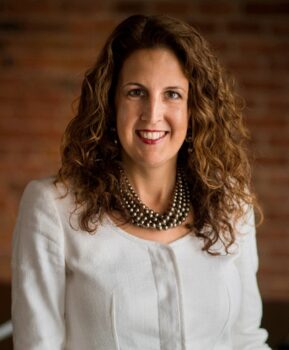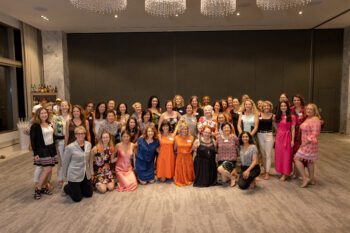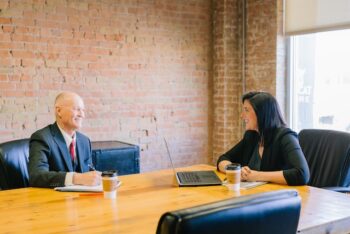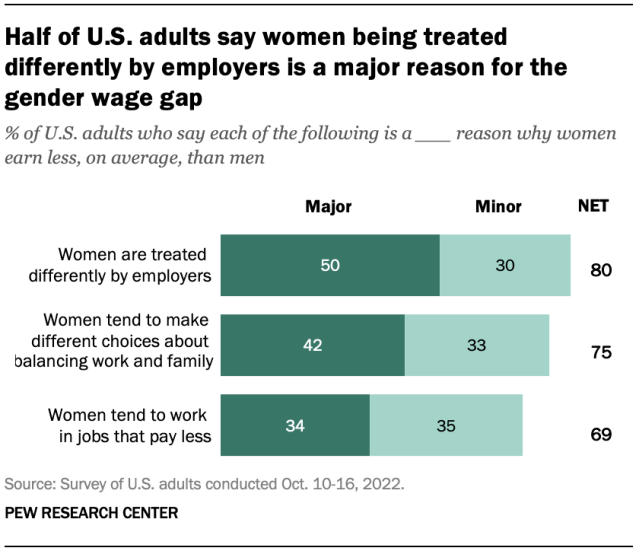“The biotech sisterhood is the antidote to the pharma bros,” said Angie You, Ph.D., Chief Executive Officer at Architect Therapeutics, during a lively conversation with Bio.News on a hot afternoon in late August.

“There is such a stereotype of the evil pharmaceutical industry. And when you hear the leaders that we have pulled together in this group, it’s remarkable! It’s remarkable how much we care about people, how much we develop people, and ultimately how much we’re impacting the industry and the economy. And there is so much more we can continue to do,” she continued.
You, along with two colleagues and friends—Julia Owens, Ph.D., President & CEO of Ananke Therapeutics (and BIO Board member) and Sheila Gujrathi, M.D., former CEO of Gossamer Bio and current Chairwoman of Ventyx, ADARx, and ImmPACT Bio—discussed an exciting development for the biotech industry: the launch of the biotech sisterhood.
As Samantha Sault, Editorial Director of Bio.News, and I listened to the conversation, we bobbed our heads in understanding: unconscious bias, issues with diversity, a lack of industry-wide solidarity are all challenges many women recognize. The idea that a powerful group of women is working to empower other women in a concrete way in one of the largest, most economically and socially impactful industries was an exciting story to hear unfold.
But what exactly is the biotech sisterhood?
It all started with the idea for a girls’ weekend.
From a ‘girls’ weekend’ to a movement

“There’s a growing number of female CEOs,” began Owens. “We should be supporting one another and tapping into each other as a resource much more systematically. We all feel so isolated—and we shouldn’t.”
“We put on our cloak, we go in, and we’re super professional, and we’re incredibly demanding of ourselves,” added Gujrathi. “We all know that as women, we have to be twice as good to get half the credit. You just have to keep delivering and the pressure is intense because you don’t get a lot of second chances.”
“We all rock it in the boardroom with all the men. We do great presenting at JP Morgan—that is not a problem,” Owens continued.
But these powerful, capable women were understandably tired, and just wanted a little support. So, they planned a “girls’ weekend.”
 According to BIO’s 2022 diversity, equity, and inclusion (DEI) report, there has been an increase in gender diversity in the biotech industry, yet the highest rungs of leadership still lack gender and racial/ethnic diversity.
According to BIO’s 2022 diversity, equity, and inclusion (DEI) report, there has been an increase in gender diversity in the biotech industry, yet the highest rungs of leadership still lack gender and racial/ethnic diversity.
While 49% of employees of the companies surveyed (36) are women, only 34% of executives are women. And just 20% of CEOs are women (with 1% not disclosed).
In this context, a simple girls’ weekend for women biotech CEOs quickly became something much more profound.
Women supporting women
They invited 50 women CEOs—a number that Gujrathi said was surprising—and 25 signed up for a weekend of fun, plus important group discussions about the challenges they face.
“We had initially planned to hold this retreat with 10 other female CEOs,” said Owens. “The next thing we knew, 10 became 12, became 15, became 20, became 25 of us—right to the point that the resort said, ‘We can’t fit anymore.’”
“Before we knew it, it ended up being this three-day magical weekend that was life changing for almost everyone who attended,” said Owens. “People started really connecting and sharing stories in amazing ways.”

“We didn’t know how it was going to go,” continues Gujrathi. “I was very nervous. But I was so incredibly (and pleasantly) surprised that the retreat exceeded all of our expectations. It was like this match that lit this flame that led to this fire that was just burning inside of all of us. We just needed to connect and feel supported and feel safe.”
“When you’re suddenly in the safe and comfortable environment you realize, ‘I have never really been surrounded by people who all get me and who all are going through all the same challenges I am,’” said Owens.
One of the main aims throughout, and after, that weekend was solidarity. Gone are the days of women competing against each other for a seat at the table. The biotech sisterhood is all about women helping women.

“While there are definitely other women, senior leaders who had preceded us,” Gujrathi explained, “I don’t think that we necessarily had a network we could rely on for success—I certainly didn’t.”
“I had just sold Amunix Pharmaceuticals right before we held the retreat,” added You. “The night Amunix announced the acquisition, I actually sent out an email to a whole group of women in the industry, thanking them, because, while people say the CEO job is lonely, I felt so lucky during my time at Amunix. I felt like I had this group of women cheering me on.”
“We’re here to support each other. We’re here to advocate for each other, and frankly, understand each other,” she continued.
Impacting the C-suite and beyond
The impact and reach the biotech sisterhood has had in its, as of yet, short existence cannot be overstated.
“It’s hard to believe that it hasn’t even been 18 months since our first retreat, especially when I think about how much has happened,” said Owens.
“This was going to be a one-time, small group of us going away for a weekend, not an entire movement that now is impacting the industry, but it is, and that’s what’s come out of this. That’s not because of just the three of us, it’s because of the collective energy of these amazing women. The sisterhood is not a formal organization,” she continued. “We go at it with the mindset of, ‘Great, someone wants to do X, Y, or Z. Go do it! We will help.’ And so a whole bunch of things have come about as a result.”
The sisterhood’s work has a wide range—the most immediate being the support women never knew they needed.
“When our group of women CEOs are together, we don’t have to explain the unconscious bias we constantly deal with,” explains You. “We don’t have to explain how many of us have been taken for the IR person, or the HR person, or even an EA—how many of us have been deemed ‘difficult’ because women have to be perfect and pleasant in every way. We deal with this vicious cycle one way or the other, where it says the bias against us is real, yet sometimes it’s hard to talk about it. However, when we talk about these issues with the biotech sisters, we’re all nodding our heads and we don’t have to explain our experiences.”
Advocacy at the core
And the role of the sisterhood has naturally grown into the realm of advocacy. The sisterhood has proved it will watch out for its own. Members often reference their network when asked for board or leadership recommendations, as well as push back on bias.
“There’s unconscious bias, especially if you’re women of color,” You laments, describing how a fellow woman in the industry was called “difficult.”
According to many studies, unconscious bias is more likely to affect women of color over any other group. For example, the Harvard Business Review has written extensively about unconscious bias across gender and racial lines in the workplace.
 In one article they explain how: “Research shows that authoritative women need to constantly monitor and edit their own behavior to get promoted—and that study doesn’t even take into account how race exacerbates this effect. Said a Latina, ‘If you present yourself as too Latina or too Black in the workplace, that could be a turnoff for your white colleagues, so you kind of have to monitor that.’”
In one article they explain how: “Research shows that authoritative women need to constantly monitor and edit their own behavior to get promoted—and that study doesn’t even take into account how race exacerbates this effect. Said a Latina, ‘If you present yourself as too Latina or too Black in the workplace, that could be a turnoff for your white colleagues, so you kind of have to monitor that.’”
Similarly, the journal Nature cites a recent study that found, “The United Nations Development Programme (UNDP) released new findings in 2020 from 80 countries as part of its Gender Social Norms Index. The report revealed that 90% of men and women hold some sort of bias against women.”
Don’t give me a blanket, ‘They’re difficult,’” You asserts. “Look at that candidate. When you talk to any investor, talent and experience matters. So I ask, ‘Okay, what are you really looking for? This person actually has all of that, right?’ Having this conversation constantly can be unfortunate, but I treat it as a constant chipping-away.”
Conversations like these lead to conversations around equal compensation and how to fight for what you are worth as a woman executive. The sisterhood has conducted salary surveys, held Zoom calls to share information, and offered advice and tactics for sisters in the midst of salary negotiations.
Advocating for women patients, too
In the political realm, the sisterhood’s advocacy has also started making waves.
“After the Dobbs decision, many of us were heartbroken and a group of women wrote a letter to politicians where we again leveraged the power of the sisterhood to expand the reach and impact of that letter with more and more signatures. And we’ve heard that people really did listen to that letter and that actually got some real attention,” added You.
For many women executives, the advocacy work can get personal.
“Right after our first summit, one of our sisters was diagnosed with breast cancer and she had a lot of challenges—even when it came to getting reimbursement and getting screened,” said You. “And, as a result, she’s working on advocacy in that arena.”
Among other activities, the biotech sisterhood has facilitated and seated panels, and partnered with organizations like BIO to organize a fly-in for women CEOs to sit down with Members of Congress.

“There’s this constant dismissal of conditions that are predominantly in women, or that manifest differently in women,” said Owens. “I have heard investors say, ‘Endometriosis is not an attractive commercial opportunity.’ Not only is that incredibly inaccurate, it is also tilted through the lens of not having a clue about a woman’s experience.”
The sisterhood’s advocacy work has already mobilized around recent issues including the legal action against mifepristone.
“It’s an extraordinary group of women who lead with compassion and authenticity,” You emphasized. But there is much, much more work to be done.
The future of women in biotech
The sisterhood clearly has an eye towards growing their numbers. Regional events from Boston to San Francisco, as well as a Slack channel, have helped maintain the connection of the original 25 sisters, as well as expand their ranks and welcome the next generation of women CEOs.
The sisterhood has also built partnerships within the investment community to both drive more money to women CEOs, but also to weather economic crises. For example, during the collapse of the Silicon Valley Bank, the sisterhood helped navigate each other’s respective companies through the storm, giving them an edge during a time of uncertainty. (And male CEOs turned to the sisterhood for the latest news, too.)
Growing leadership through recruitment and referrals
The sisterhood works to increase the number of female academic founders and board members, still in the single digits.
“I, myself, met with all the female professors who wanted to pitch a company and helped them learn how to write a business plan. Ultimately, some of them were successful,” said You.
As Gujrathi explained, many women CEOs are first-time CEOs and founders of their own companies. Yet: “They get a company to a certain stage and then they’re replaced. Why?” she asked. “After they’ve done an incredible amount of work to set the company up for success, deliver on milestones, and even close on major financings or BD deals. Where’s the support network? Where do you turn?”

“We got your back. Call us,” emphasized Gujrathi. “We’re constantly giving out referrals and trying to help people navigate. But it’s sad that we continue to hear these stories—not surprising, we don’t expect change overnight, but there’s still a lot that needs to be done.”
And so the sisterhood’s work starts to come full circle: advocate for patients, support and grow women in leadership, and protect women’s positions at the top of the biotech world.
“Women need to realize that we have very active, important voices in our organizations. We want to see more women in the C-suite,” concluded Gujrathi. “We want to see more women on the board. We want to empower women with choice—for where they work and who they work for. We are more powerful than we believe or that we know. I hope we’ll reach the tipping point where we’ll see explicit demand for diversity at every level of our companies.”









